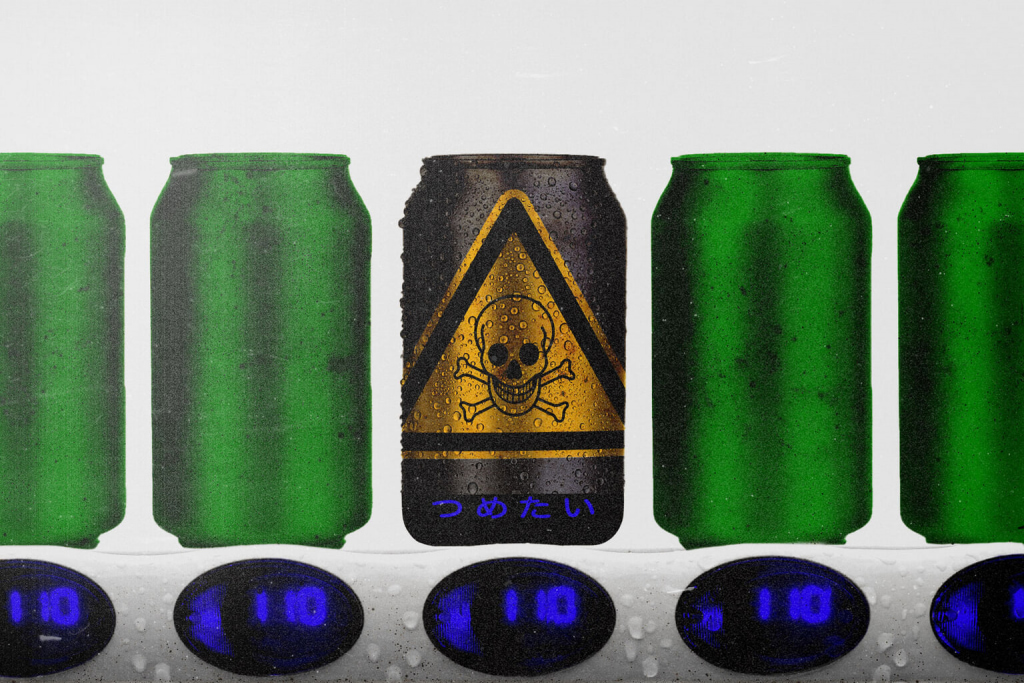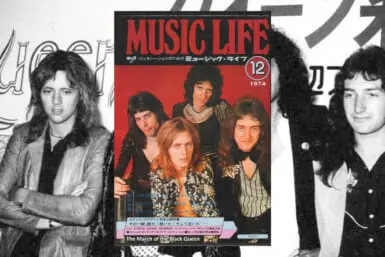On this day 53 years ago the San Oku En Jiken (¥300 Million Robbery) occurred in Tokyo. The perpetrator of the daring heist was never caught making it one of the most famous unsolved mysteries in Japan. We covered that here along with four other well-known unresolved cases, so this time we’re focusing on seven different crimes that left the police in this country scratching their heads or on some occasions, framing the wrong person.
1. The Wednesday Strangler
Between 1975 and 1989, seven women were murdered within a 20-kilometer radius of each other in Saga Prefecture. All but one of the victims vanished on a Wednesday. Five were discovered strangled, while the other two were skeletonized meaning the cause of death couldn’t be ascertained. It all began with the disappearance of a 12-year-old girl at a phone booth in the town of Kitagata in the summer of 1975. Last seen with a man, she was found dead in a toilet stall next to an elementary school.
Her body was discovered in June 1980. That same month, the body of a 20-year-old was also found at an elementary school toilet. The next victim was a 27-year-old factory employee in 1981 followed by an 11-year-old fifth-grader the next year. In January 1989, a couple driving near a mountain forest in the Kishima region saw three bodies beneath a cliff. Later that year, a 26-year-old man confessed to their murders. Almost two decades later, he was acquitted with the Saga police admitting they’d over-interrogated him. The statute of limitations subsequently passed on all seven crimes.

Three of the five victims vanished from a pachinko parlor
2. North Kanto Young Girl Serial Kidnapping and Murder Case
On a December morning in 1991, the police barged into Toshikazu Sugaya’s house and demanded answers. He was accused of kidnapping and killing four-year-old Mami Matsuda. She had gone missing from a pachinko parlor in Ashikaga, Tochigi Prefecture a year and a half earlier. Her body was then discovered in a nearby river. Denied access to food, water and a lawyer, Sugaya was interrogated, sometimes violently, for hours. Relenting, he eventually confessed to the crime and spent 17 years in prison based on primitive DNA evidence.
Re-investigating the case in the late 2000s, award-winning journalist Kiyoshi Shimizu discovered that parts of Sugaya’s confession were impossible and the DNA testing method was imprecise. The accused was consequently released. Shimizu also claimed there was enough evidence to charge the real criminal, but the statute of limitations had passed. The disappearance of Yukari Yokoyama, however, was still an open case. Taken from a pachinko parlor in 1994 when she was four, Yokoyama hasn’t been seen since. Shimizu is certain the same man snatched both girls. There are similarities between the two cases and the kidnappings and murders of Maya Fukushima, 5, Yumi Hasebe, 5 and Tomoko Oosawa, 8, the three girls who died between 1979 and 1987. None of the crimes have been resolved.

Photo by Robin Lee / Shutterstock
3. The Vending Machine Killer
Launched in 1965, Oronamin C health drinks proved hugely popular in the early days. By the 1980s, however, sales were dwindling among young people. Otsuka Pharmaceutical Co., Ltd., subsequently decided to launch a campaign. Customers purchasing any bottle at certain vending machines would additionally receive Oronamin C for free. While some were glad to get the extra drink, others simply left it behind. On April 30, 1985, a truck driver spotted the freebie on top of a machine in Fukuyama, Hiroshima and drank it. A month later he was dead.
Tests showed he was killed by paraquat, a herbicide that’s toxic for humans and banned in many countries. Between September and November of that year, 11 more people died in similar circumstances. 10 were poisoned by paraquat, the other one by diquat. Most had consumed Oronamin C, though the energy drink Real Gold and Coca-Cola were also linked to the deaths. All appeared to be indiscriminate targets. Vending machines posted notes warning customers not to take drinks found in or around the machines. The police had no leads and the case subsequently went cold. The crime spree came not long after the infamous Glico Morinaga poisonings.

Salman Rushdie’s book Satanic Verses inadvertently led to the murder of Hitoshi Igarashi. Photo Credit: Hillel Steinberg / Flickr.com
4. The Satanic Verses Murder
The release of Salman Rushdie’s book The Satanic Verses in 1988 proved hugely controversial. Though highly acclaimed in Rushdie’s home country of the UK, the Booker Prize-winning publication angered much of the world’s Muslim communities. On Valentine’s Day in 1989, the Supreme Leader of Iran Ayatollah Ruhollah Khomeini issued a fatwa condemning the British author to death. Fortunately, Rushdie managed to survive several assassination attempts. In 1991, Khomeini’s successor Ali Khamenei issued another fatwa and multimillion-dollar bounty for anyone involved in the publication.
That included Hitoshi Igarashi, the man who translated The Satanic Verses into Japanese. On July 12 of that year, a cleaning lady found the Japanese scholar’s dead body at his office at the University of Tsukuba in Ibaraki Prefecture. 10 days earlier, Italian translator Ettore Capriolo was stabbed multiple times in his home, but survived. In 1993, William Nygaard, the man responsible for publishing the book in Norway, was shot three times outside his home. He eventually recovered and in 2018 charges were made against the two alleged perpetrators. Igarashi’s killer(s), however, has never been brought to justice.

The iconic park in Tokyo where Seiichi Kawamura’s body parts were discovered. Picture by Masami.K / Shutterstock
5. Inokashira Park Dismemberment
35-year-old architect Seiichi Kawamura was last seen on the evening of April 21, 1994. After eating dinner with his family, he went to karaoke with an old colleague in Shinjuku before heading back to his house near Inokashira Park. He never made it home. Two days later, parts of his body were discovered in a trash can at the park. They were found by a cleaner. She thought the bag contained raw fish, which she planned to feed to stray cats. Instead, a human ankle fell out.
There was a total of 24 human pieces including hands and feet. His head, chest and genitals, though, were never found. Each part had been drained of blood and carefully sliced into 20-centimeter pieces. Two suspicious men were reportedly seen in the park carrying plastic bags, but neither was identified. Friends and acquaintances of the deceased were interviewed at length by the police, yet no arrest was made. In 2009, the statute of limitations for the case expired. A year later, the country’s Criminal Procedural Law abolished that ruling for murder and other crimes resulting in death.
6. The Hachioji Supermarket Triple Murder
It was one of the most notorious crimes of the 1990s, yet more than 26 years on and there’s still no resolution to the Hachioji Supermarket Murders. In the morning of July 30, 1995, Hiromi Maeda, 16, Megumi Yabuki, 17, and Noriko Inagaki, 47, were all bound with tape before being shot in the head. The incident took place on the second-floor office of the Nanpei Owada Supermarket where the three women worked. The safe in the office was full of money, but none was taken.
With no arrests made, the National Police Agency continues to offer a reward of ¥6 million for information that leads to the capture of the culprit. Just over a decade ago, a Japanese man on death row in China for drug trafficking claimed a Chinese national he was in a gang with was responsible for the crime. After gaining Canadian citizenship, the Chinese man was extradited to Japan in 2013 for passport fraud but has never spoken about the supermarket murders. Another suspect, whose fingerprints closely matched those on the sticky tape found at the crime, died in 2005. Police believe he wasn’t in the area at the time of the incident.

The Myojo Fire occurred in Shinjuku’s lively Kabukicho district
7. Myojo 56 Building Fire
In the early hours of September 1, 2001, a fire broke out on a stairway between the third and fourth floors of the Myojo 56 building in the notorious Kabukicho district of Shinjuku. 44 people died in the blaze that took five hours to extinguish. The main cause of death was carbon monoxide poisoning. Numerous safety violations reportedly exacerbated the situation with fire doors and stairwells being blocked. Three individuals working in the building suffered injuries after jumping from the third floor. Some managed to escape to the roof.
Six people, including two executives from the Myojo Kosan Group, were arrested on charges of professional negligence resulting in death. In 2008, five of them were convicted while one was acquitted. As for the cause of the fire, Tokyo Police concluded it was most likely arson, though that’s never been confirmed. Witnesses reported that they saw a suspicious man leaving through the front door around the time of the incident, but he wasn’t identified. Despite speculation linking the yakuza and an “illegal gambling den” to the crime, it remains unsolved.
*Feature image by Anna Petek











